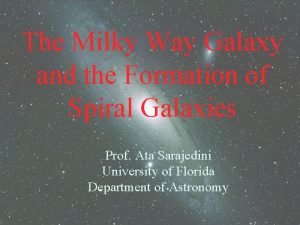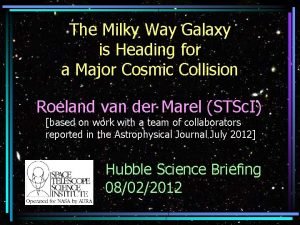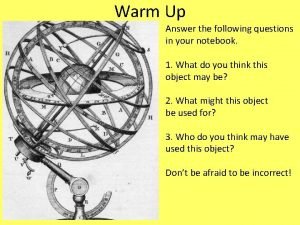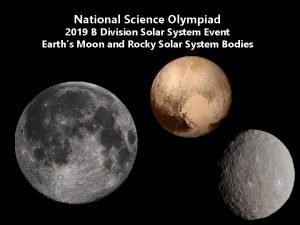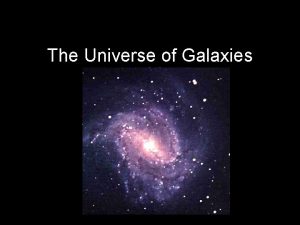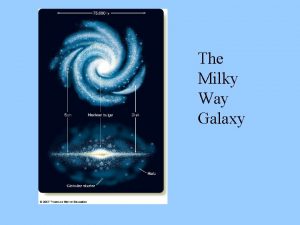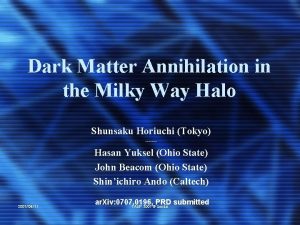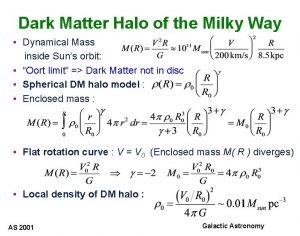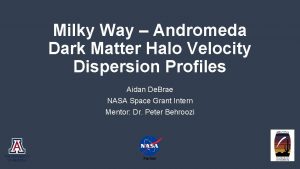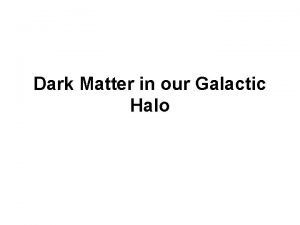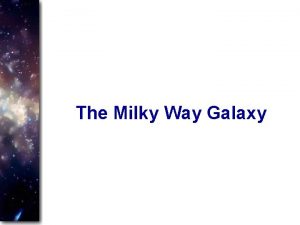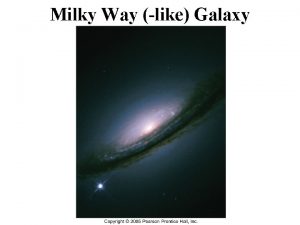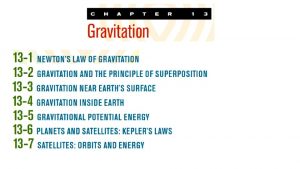Dark Matter Annihilation in the Milky Way Halo












- Slides: 12

Dark Matter Annihilation in the Milky Way Halo Shunsaku Horiuchi (Tokyo) ------- Hasan Yuksel (Ohio State) John Beacom (Ohio State) Shin’ichiro Ando (Caltech) 2007/09/11 ar. Xiv: 0707. 0196, PRD submitted TAUP 2007 @ Sendai

Brief review… Much evidence for its existence, but their true nature is unknown Fundamental Question: what is dark matter ? Is it a particle (WIMP)? Extensions of SM predict weakly interacting particles that has the right properties, e. g. the Neutralino Search for new particles as dark matter candidates 2007/09/11 TAUP 2007 @ Sendai Indirect detection: detect signatures of pairannihilation Photons, neutrinos, etc Annihilation rate ∝r 2 2

Where do we observe? Places where the dark matter is strongly concentrated, for example: – – – Galactic centre Bengtsson et al. ‘ 90, Berezinsky et al. ’ 94, … near black holes Gondolo&Silk ’ 99, Bertone et al. ’ 05, … Dwarf satellite galaxies, e. g. DRACO Bergstrom ‘ 06, Profumo ‘ 06 Nearby galaxies, e. g. M 31 Extragalactic Ullio et al. ’ 02, … – Microhalos Narumoto&Totani ’ 06 Diemand et al. 2007/09/11 TAUP 2007 @ Sendai 3

Galactic Centre Flux of dark matter annihilation signal well studied [Bengtsson et al (‘ 90), Berezinsky ’ 94, Bergstrom & Ullio (‘ 97), etc ] i = g, n, e, p, … DM particle properties Region of interest m > O(100) Ge. V DM density distribution Normalizing the line of sight integral to the solar dark matter density Js, we can define J : dimensionless enhancement factor 2007/09/11 TAUP 2007 @ Sendai 4

Galactic Centre (2) GC flux predictions can vary considerably Inner (<1 pc) profile uncertain: n N-body simulations generally predict a cusp n observations show no clear evidence of a cusp/core This causes a large difference. Also, n effects of baryons [Prada ‘ 04] n background [Zaharijas ‘ 06] 2007/09/11 TAUP 2007 @ Sendai Profile γ Ave J Moore 1. 5 3× 104 NFW 1. 0 103 Kra 0. 7 30 5

Uncertainties As we’ve seen, dark matter concentrations increase the annihilation rate good for detection. But distribution uncertainties cause large uncertainties > order magnitude) in the predicted flux. n n n ( Galactic Centre: cusp/core problem, effects of baryons, large astrophysical background Near BHs: Formation and survivability of spikes (Ullio+’ 05) Extragalactic signal:mass-function cut-off, concentration parameter To obtain constraints from null detections, we want to minimize the uncertainties caused by dark matter distribution…are there other regions where the flux and background are better known? 2007/09/11 TAUP 2007 @ Sendai 6

The Whole Milky Way? Consider a larger field of view – the entire Milky Way halo Average enhancement (J) for different profiles and FOVs: More profile independent Model ~1 deg ~30 deg ~180 deg Anti. GC Moore 3× 104 102 8 0. 3 NFW 103 26 3 0. 4 Kra 30 13 2. 6 0. 55 Define: Halo Angular Halo Average Halo Isotropic 2007/09/11 Field of View TAUP 2007 @ Sendai 7

Flux strength For illustration, consider Neutralino → g rays Use NFW Normalize to the GC flux Flux smaller…but more robust, and less background. Halo Isotropic component is as large as (or larger than) the truly cosmic component! 2007/09/11 TAUP 2007 @ Sendai 8

Neutrino Bound There are numerous dark matter candidates (or “models”) d. N/d. E varies between models. How do we then place a model independent constraint on the total annihilation cross section? Ref [Beacom et al. 2006] noted that given something is produced, the hardest to detect particle will set the uppermost limit. c SM particles; “visibile” + “invisible” c Assuming that only neutrinos are produced (i. e. cc nn), from the null detection in the atmospheric neutrino background, they placed a model independent limit of sv < 10 -21 cm 3 s-1 2007/09/11 TAUP 2007 @ Sendai 9

Neutrino Bound (2) Previous neutrino bound considered the cosmic dark matter annihilation signal. We extend this by considering annihilation from the Milky Way Halo Atmospheric muon neutrino from Frejus, Super-K, AMANDA (ignore angular dependence) Use Energy bins of: Dlog E = 0. 3 [Halo] Dlog E = 0. 5 [Cosmic] Detection requirement: signal is double background 2007/09/11 TAUP 2007 @ Sendai 10

Improved Neutrino Bound Halo Isotropic previous cosmic consideration Whole Milky Way halo This is good because: 1. the fluxes are larger 2. it relies on different physics and is more robust 2007/09/11 TAUP 2007 @ Sendai Mass [Ge. V] 11

Conclusions n n Uncertainties in the dark matter distribution make constraining dark matter particle properties hard. We analyzed the Milky Way halo to show that: – Uncertainties in the predicted annihilation flux are reduced considerably by observing larger FOVs – The galactic halo isotropic component is larger than the truly cosmic signal n n Using the Milky Way halo components, we improved the previous Neutrino bound by 1 -2 orders. Dedicated analysis using better Energy resolution and better criteria, angular dependency, can further improve the Neutrino bound. [Kachelriess 2007] 2007/09/11 TAUP 2007 @ Sendai 12
 Halo halo tutaj ptasie radio
Halo halo tutaj ptasie radio Dark matter and dark energy ppt
Dark matter and dark energy ppt Canis major overdensity
Canis major overdensity Milky way galaxy sketch
Milky way galaxy sketch Where is the solar system located in the milky way
Where is the solar system located in the milky way Dung beetle milky way
Dung beetle milky way My fonterra milky way
My fonterra milky way Democritus milky way
Democritus milky way Our location in the milky way
Our location in the milky way Critical density
Critical density Milky way galaxy
Milky way galaxy The milky way
The milky way Milky way description
Milky way description


